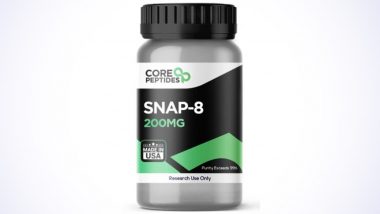SNAP-8 is a peptide that has been hypothesized to reduce the appearance of wrinkles. This peptide corresponds to the N-terminus of SNAP-25.
Research suggests it may affect production by contending with SNAP-25 for its part in the SNARE complex. The SNARE complex is a significant protein family that harnesses energy through interactions between proteins and lipids, all while facilitating the fusion of membranes. Modifications to the SNARE complex will impede neurotransmitters' release from vesicles, interrupting muscle contraction and averting the formation of wrinkles along the skin’s surface.
SNAP-8 peptide, or Acetyl Glutamyl Heptapeptide-1, is a hexapeptide considered an Argireline elongation. SNAP-8, similar to other peptides based on hexapeptides, has been purported to exhibit a strong potential to reduce wrinkle depth. Research suggests the peptide may prevent any disturbance to the lipid matrix's ideal arrangement.
Investigations purport that the SNAP-8 peptide may offer a unique and advantageous alternative to Botulinum Toxin as it may target the mechanism behind wrinkling in a more organic and innovative pathway.
SNAP-8 Peptide Potential
The skin's wrinkling is a highly visible manifestation of the aging process in the living body. This happens organically over time, and physical changes are intensified by environmental exposure. The consistent force of gravity, along with the regular and ongoing pressure exerted on the skin may lead to the formation of folds, furrows, or creases. These are caused by the repetitive contractions of muscles.
Muscle contraction is initiated by the release of neurotransmitters from vesicles. The SNARE complex plays a paramount role in muscle contraction by serving as a cellular hook that captures vesicles and facilitates their fusion with the membrane, enabling the release of neurotransmitters.
The SNAP-8 peptide has been speculated to disrupt the normal functioning of the SNARE complex, leading to a decrease in the efficient production of neurotransmitters and a visible reduction in the presence of lines and wrinkles.
Scientists propose that the SNAP-8 peptide may inhibit the release of catecholamines, which leads to a noticeable decrease in facial lines and wrinkles. The inhibition of catecholamines may also impact stabilizing muscle contractions by activating the Ca2+ ion.
The SNAP-8 peptide has also been purported to enhance collagen production and release, resulting in stronger, more resilient skin less prone to wrinkle development and depth increase.
Studies suggest the SNAP-8 peptide functions by potentially inhibiting muscle contractions, enabling muscles to reach optimal homeostasis levels.
The SNAP-8 peptide has been suggested to significantly decrease the appearance of periorbital wrinkles, resulting in a reduction of about 63.13% in severity. Investigations imply that the peptide's potential may surpass its parent peptide, Argireline, by up to 30%.
Glutamate is a neurotransmitter that has the role of stimulating neurons. As suggested by the findings, it is speculated that the combination of SNAP-8 and Leuphasyl may exhibit a more potent inhibitory impact on glutamate than individual peptides. Meanwhile, glutamate triggers muscle contractions, leading to the formation of wrinkles and fine lines. By suppressing glutamate release, wrinkles and fine lines may potentially be prevented.
As a study published in a scientific journal purported, the results suggested a significant correlation between the two variables. The researchers conducted a rigorous experiment and collected data from a large sample size to ensure the validity of their findings. This study's findings contribute to scientists' speculation that the peptide may function by inhibiting the transmission of signals between nerves and muscles, potentially reducing the appearance of wrinkles caused by excessive neuronal activity.
An experiment was conducted on ten female research models. The substance used in the experiment contained a solution with a concentration of 10% Argireline. The findings suggested that the placebo appeared to have resulted in a decrease of 2.99% in wrinkle reduction. In comparison, Argireline seemed to have led to a more significant decrease of 27.05%, and the SNAP-8 peptide suggested the most substantial decrease of 34.98% in wrinkle reduction.
After these comparisons, it was purported that 10% of the SNAP-8 solutions may have achieved a remarkable wrinkle reduction of -63.13%. As implied by the available data from the manufacturer's website, the scientists have suggested that the maximum wrinkle reduction achieved may be 62%, with an average reduction of 35%. These findings suggest that SNAP-8 may be a potentially efficient peptide within the context of wrinkle and epidermal research.
Please note that the products discussed are not meant for use by humans or animals. Research chemicals are designed exclusively for laboratory experimentation and in-vitro testing purposes. Any form of bodily introduction is strictly prohibited by law. Only licensed researchers and qualified professionals are eligible to make purchases from Core Peptides. The information provided in this article is intended solely for educational purposes.
References
[i] Ji, Moongi, et al. “Method development for acetyl octapeptide-3 analysis by liquid chromatography-tandem mass spectrometry.” Journal of Analytical Science and Technology 11 (2020): 1-7.
[ii] Backardzhiev, Ilko, and Dona Filcheva. “Peptides in dermatocosmetics.” Journal of Varna Medical College 4.1 (2022): 45-49.
[iii] Avcil, Muhammet, et al. “Efficacy of bioactive peptides loaded on hyaluronic acid microneedle patches: A monocentric clinical study.” Journal of Cosmetic Dermatology 19.2 (2020): 328-337.
[iv] Raposio, Edoardo, et al. “EVALUATION OF EFFECTIVENESS OF VIPER SERUM FOR TOPICAL USE AS FACIAL ANTI-AGING.” (2009).
[v] Gutierrez, Luis M., et al. “A peptide that mimics the C-terminal sequence of SNAP-25 inhibits secretory vesicle docking in chromaffin cells.” Journal of Biological Chemistry 272.5 (1997): 2634-2639.













 Quickly
Quickly











